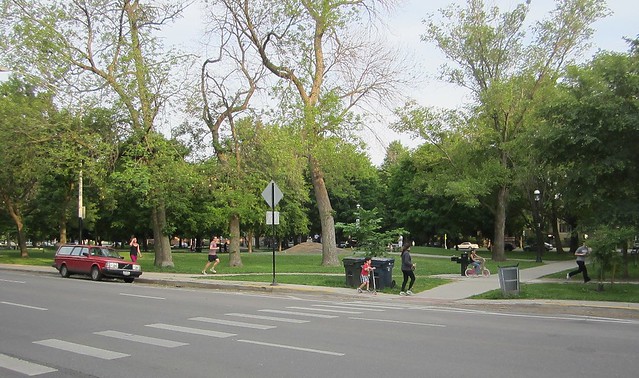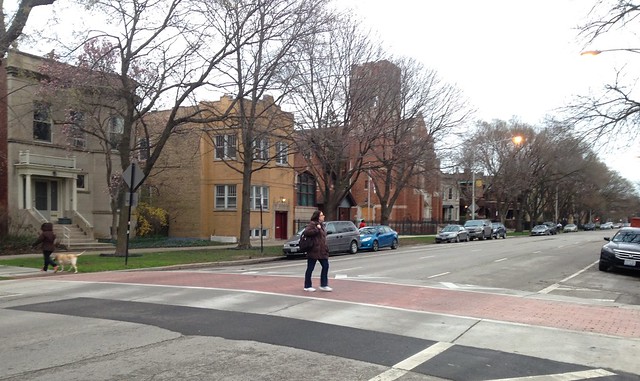Yesterday evening Steven Vance and I conducted speed counts that quantify what we already suspected to be true. The new raised crosswalks on the north side of Palmer Square park are calming traffic and making it safer for residents to access the green space. While, prior to installation, about 75 percent of motorists on the street were observed exceeding the 25 mph speed limit, yesterday less than 38 percent of them were.
Last December the Chicago Department of Transportation converted the two marked, mid-block crosswalks on the north side of the park to raised crosswalks, also known as speed tables. 32nd Ward alderman Scott Waguespack funded the $115,000 project, which also included additional curb-and-gutter work, with ward menu money.
The change came about after years of advocacy by neighbors who said the quarter-mile stretch of Palmer Boulevard north of the green space was plagued by speeding. The street has three westbound travel lanes, with light traffic volumes and no stoplights or stop signs, which encourages high speeds.
In July 2014, Steven and Streetsblog contributor Justin Haugens used a speed gun to measure motor vehicle speeds on the north side of the park during the evening rush. During three 15-minute observations between 5:30 and 6:30 p.m., they clocked 168 drivers — 75 percent of all observed motorists — exceeding the posted 25 mph speed limit. About a third of all observed drivers were going faster than 30 mph, the default citywide speed limit. Five drivers exceeded 40 mph.
Soon after the safety infrastructure went in, I observed that drivers were hitting their brakes as they approached the crosswalks. Last night Steven and I conducted two 15-minute counts between 5:45 and 6:30 p.m. on the westbound roadway. We did one count about a quarter of a block west of the easternmost speed table, and the other at about the same distance west of the westernmost one.
Out of the 93 motorists we clocked, only 35 – less than 38 percent – were exceeding the 25 mph posted speed limit. Only five drivers were going faster than 30 mph – that’s less than 6 percent. And no one was driving faster than 36 mph.

Studies show that while pedestrians struck at 40 mph almost always die, and those struck at 30 mph have a roughly 50/50 chance of survival, those struck at 20 mph almost always survive. This means that the change in vehicle speeds on Palmer, brought about by the raised crosswalks, could very well mean the difference between life or death in the event that a person on foot is struck while crossing.
And of course, the reduction in speeding, along with the fact that pedestrians using the red, raised crosswalks are more visible to motorists, means it’s less likely a crash will occur in the first place.
Locals seem to appreciate the change. When a 14th District police officer drove up to us, we thought he was going to scold us for using the speed gun, but instead he said he appreciates the fact that the new speed tables are there because so many small children use the park.
Guillermo Meca-Ortega, who lives nearby with his three-year-old daughter, was one of the neighbors who petitioned for the raised crosswalks. After jogging on Palmer Square’s soft-surface track, he stopped by to tell us he feels the infrastructure is working well, although there are sometimes issues with drivers who speed up after going over the speed tables in order to catch a green light at Kedzie Boulevard. We observed this as well.
His neighbor Steve Hier, who’s lived on the block since 1977, also lobbied for the change. He agrees that the raised crosswalks have been a big improvement. “This park is incredibly well used, so it’s great that this is having an effect on drivers,” he told us. “People stop if they even see that you’re about to enter the crosswalk. Before it was more like, ‘Get the hell out of the way.’”
Still, Hier would like to see further improvements to the street. He says that, since the roadway on the north side of the park has three lanes, while the one on the south side has only two, a road diet on the north side would have been a logical solution to the speeding problem, and it still makes sense.
However, nearby churches use the central travel lane of the three-lane street for Sunday parking, which isn’t technically legal but has been tolerated by aldermen for many years. Eliminating that privilege might be politically difficult for Alderman Waguespack.
A possible solution would be to convert the curbside parking along Palmer Boulevard to angled spaces, preferably back-in parking, since that eliminates the need to back out into oncoming traffic. That street reconfiguration would maintain plenty of parking spaces for parishioners, while further improving safety.






